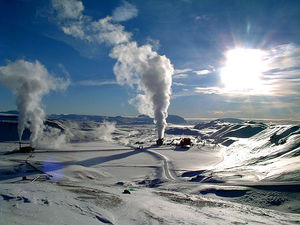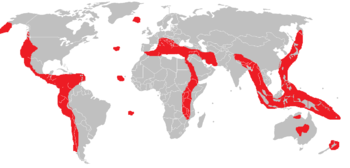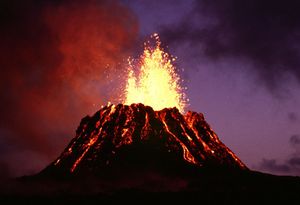Geothermal energy


Geothermal energy is energy that is extracted from thermal sources that originate deep underground. Geothermal energy is a form of primary energy. It can be used directly for heat or to create electricity. Deep underground, the Earth will remain hot for billions of years, so geothermal energy can be used for a long time (as a renewable energy source), but if the resource is not treated carefully, it will not be sustainable.
Geothermal energy is extracted in the form of steam or hot water from the subsurface, which can then be used for many purposes (see geothermal electricity and heating). Countries around the world are currently limited by technology when it comes to harnessing geothermal energy, and only those lying on certain "geothermal hot spots" (Figure 2) may tap into this energy effectively.[3]
A benefit of geothermal energy is that it is not intermittent like solar and wind power, which means it can be used at any time of the day, any day of the year. This makes it fairly reliable, and allows its use as a baseload power provider to the electrical grid.
Since not all countries can feasibly extract this energy, geothermal energy is not in prominent use globally. It makes up less than 1% of the world's primary energy supply. Some countries, like Iceland, do get a large fraction of their primary energy from geothermal sources (see the data visualization below). The largest producers of geothermal energy in the world include the United States, China, Turkey, Iceland, Japan, Hungary, and New Zealand.[4]
Heat from the Earth
The interior of the Earth is extremely hot, and even reaches temperatures of over 6000°C at the core, about the same temperature as the surface of the Sun.[5][6]
A large portion of the Earth's heat comes from radioactive heating caused by the decay of elements such as Uranium and Thorium. These elements aren't found in the core however, with the most popular model suggesting that they are found in the lithosphere and mantle. This form of heating is said to account for 50% of the Earth's heat, with the remaining heat coming from the primordial heat of the Earth (heat from the Earth's formation).[7]

Hot Spots
Temperatures near the surface are actually not that hot, which means that the energy available for human use is fairly "low-quality" (see Entropy for information on qualities of energy). Most energy applications require higher temperatures to make work in heat engines effective.[3]
If a country is situated on a hot spot (Figure 2), this hot spot may produce high temperature heat that can generate electricity efficiently. These hot spots occur because of their location near tectonic plate boundaries where the crust is thinner, and where plumes of magma may extend close to the surface.[3]
Normally, the Earth becomes hotter by about 25°C per kilometer of depth (see geothermal gradient). In these hot spots this value can get over 60°C per kilometer of depth, ideal for harvesting geothermal energy.[3]
Sustainability
Geothermal energy can become depleted in a specific location, making that particular well site non-sustainable. This problem often comes from people bringing up the underground hot water faster than it can replenish. Various geothermal power plants, such as one at the Geysers in northern California, have over-extracted the water and heat at their sites, resulting in a decline in power production.[3] Water is being re-injected into the site, which may help with this problem. The extraction of geothermal energy must be carefully managed at every site in which it is used in order to keep it sustainable.
Data Visualization
The visualization below shows how much primary energy a country produces. It is preset to Iceland to show their dependence on geothermal energy; however, several other countries use geothermal energy in large amounts, such as Costa Rica (and other countries in Central America). The countries bordering the Ring of Fire seen in Figure 2 use geothermal energy, while there is also a similar hot spot in Central Europe and Eastern Africa including countries such as Italy, Kenya, and Turkey.
For Further Reading
- Energy
- Radioactive decay
- Fossil fuel
- Electricity
- Earth
- Or explore a random page
References
- ↑ Wikimedia Commons [Online], Available: https://commons.wikimedia.org/wiki/File:Krafla_geothermal_power_station_wiki.jpg#/media/File:Krafla_geothermal_power_station_wiki.jpg
- ↑ Adapted from: R. Wolfson, "Energy from Earth and Moon" in Energy, Environment, and Climate, 2nd ed., New York, NY: W.W. Norton & Company, 2012, ch. 8, pp. 204-224
- ↑ 3.0 3.1 3.2 3.3 3.4 R. Wolfson, "The Geothermal Resource" in Energy, Environment, and Climate, 2nd ed., New York, NY: W.W. Norton & Company, 2012, ch. 8, pp. 204-218
- ↑ World Energy Council, "World Energy Resources Geothermal 2016". Accessed Oct.22, 2018. Available from: https://www.worldenergy.org/wp-content/uploads/2017/03/WEResources_Geothermal_2016.pdf(
- ↑ D. Alfè; M. Gillan & G. D. Price (January 30, 2002). "Composition and temperature of the Earth's core constrained by combining ab initio calculations and seismic data" (PDF). Earth and Planetary Science Letters (Elsevier) 195 (1–2): 91–98. Bibcode:2002E&PSL.195...91A. doi:10.1016/S0012-821X(01)00568-4.
- ↑ National Geographic. (August 18, 2015). Inside the Earth [Online], Available: http://science.nationalgeographic.com/science/earth/inside-the-earth/
- ↑ Physics World. (2011). Radioactive decay accounts for half of Earth's heat [Online] Available: http://physicsworld.com/cws/article/news/2011/jul/19/radioactive-decay-accounts-for-half-of-earths-heat
- ↑ Wikimedia Commons [Online], Available: https://upload.wikimedia.org/wikipedia/commons/6/6d/Puu_Oo_cropped.jpg

